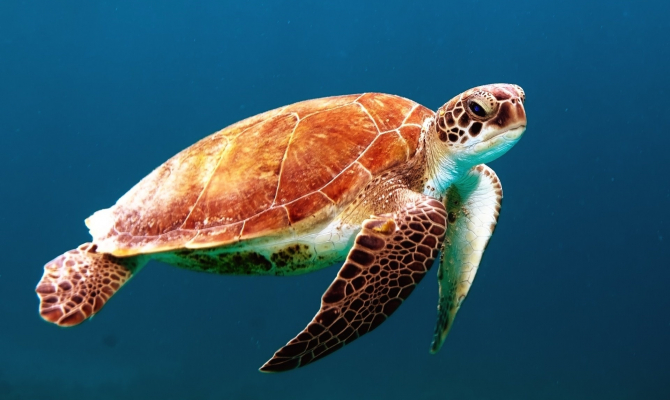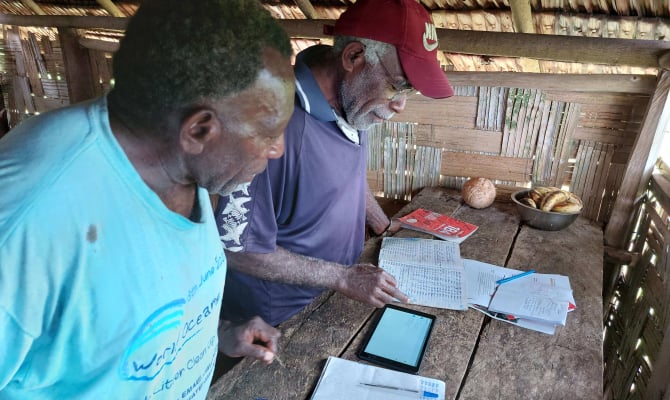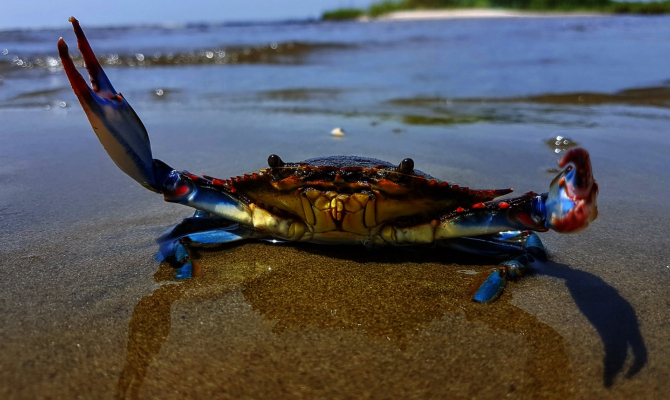Review of Vanuatu’s turtle management and conservation to promote the recovery of the Pacific’s turtle populations considering climate change, coastal development, and offshore tuna by-catch
A national review is underway in Vanuatu to determine the current state of marine turtle management and conservation in the country.
Marine turtles are ancient reptiles that have been in the Pacific since dinosaurs roamed the earth and are very important to Vanuatu’s natural and cultural heritage. However, turtles are globally threatened species and listed as vulnerable, endangered or critically-endangered on the International Union for Conservation of Nature (IUCN) Red List of Threatened Species.
Vanuatu’s marine turtle review is a key activity of the By-catch and Integrated Ecosystem Management (BIEM) Initiative being implemented by the Secretariat of the Pacific Regional Environment Programme (SPREP) via the Pacific-European Union Marine Partnership (PEUMP) programme with Vanuatu government agencies and community partners.
“The review of turtle management and conservation is timely given that it has been 16 years since the last regional Year of the Turtle in 2006,” said Kalo Pakoa, the BIEM Initiative Coordinator in Vanuatu.
“A lot has changed in the last 16 years, so it makes good sense to review Vanuatu’s turtle management in the light of new challenges, such as climate change, coastal development, and offshore tuna by-catch.”
The national review of the current state of marine turtle management and conservation in Vanuatu will strengthen the country’s management activities to promote the recovery of the Pacific’s turtle populations.
The review included consultations with key stakeholders, including the Vanua-tai Turtle Network, the Vanuatu Fisheries Department, the Department of Environmental Protection and Conservation, the Vanuatu Cultural Centre, the Department of Tourism and SPREP.
Vanuatu’s Marine Turtles
Vanuatu is home to five species of marine turtle. The green, hawksbill and leatherback sea turtles are the three most common species found to nest in Vanuatu. Hawksbill and leatherback turtles are listed as critically endangered on the IUCN Red List, while the green turtle is listed as endangered. The olive Ridley and loggerhead turtles are listed as vulnerable and are also found foraging in Vanuatu’s coastal waters and migrate to other parts of the Pacific. More data is needed to confirm if significant numbers of these two species also nest within Vanuatu.
“Sea turtles are a prominent feature in the coastal areas of Vanuatu, and many of our beaches provide nesting areas for turtles,” said Pakoa.
“However, it may surprise many people that turtles that nest in Vanuatu do not stay to feed here but migrate thousands of kilometres to relocate to their foraging grounds and then return again to the same Vanuatu beaches to nest. These lengthy migrations mean they face a number of dangers navigating the high seas.”
All five species of turtles found in Vanuatu waters are essentially a shared resource regionally and internationally. Hence the need to liaise with other countries in Oceania and Asia to ensure that turtles are protected throughout their life cycle, including while migrating on the high seas.
Unfortunately, sea turtles face many threats and challenges, including boat and ship strikes, being caught as by-catch in offshore tuna fisheries, entanglement in lost ‘ghost’ fishing nets and plastics, water pollution, illegal poaching and consumption of turtles and their eggs by people.
Coastal development for housing and tourism that often include seawalls, fences and bright lights also alienates beaches used for nesting. Climate change and the potential increase in cyclones and intensity increase the risk of damaging turtle nests, as does sea-level rise.
National turtle review
The current marine turtle review is an opportunity to look back and assess Vanuatu’s turtle management strategies, including customary management, legislative protection, and community monitoring of turtle nesting and foraging habitats.
Vanuatu introduced legislation under the Department of Fisheries to protect marine turtles in 1983, with additional legislation introduced in 2005, 2009, 2010 and 2014.
Under current legislation, it is illegal to catch, harm or consume sea turtles or their eggs, or interfere with nesting. It is also illegal to capture and keep turtles in enclosures without a permit. However, there is an option to catch and eat turtles for customary practices through a Department of Fisheries ‘traditional take’ permit.
Community turtle research
Vanuatu’s grassroots community-based Vanua-tai (Land and Sea) Resource Monitor Network is closely involved in monitoring nesting and foraging activities of marine turtles, as well as working with communities to improve management.
“The recognition of the decline of our turtle population across the region and the need for conservation education helped to initiate the successful community-based Vanua-tai Network on north Efate, which has spread north and south to Torba and Tafea provinces,” said Pakoa.
The Vanua-tai Network also supports a turtle tagging programme where a turtle’s flippers are tagged to assist in tracking turtle migrations and studying regional connectivity. Satellite tagging research of hawksbills nesting on Moso Island in Shefa province also provides insights into where these turtles go after nesting. To date, this study has revealed that Moso’s hawksbills migrate to feed in New Caledonia and the Great Barrier Reef of Australia.
Customary Management Strategies
Turtles have high cultural value for most of the cultural-linguistic groups of Vanuatu, and they feature prominently in many kastom stories. Archaeological records confirm turtles have been part of traditional diets since the arrival of the Lapita people some 3,000 years ago.
“For many of our cultures, the value of turtles is similar to pigs, which are highly venerated for cultural purposes and as a traditional food,” said Francis Hickey from the Vanuatu Cultural Centre.
Research conducted by the Centre indicates traditional management strategies have long been in use to control and minimise turtle hunting and taking of eggs, especially during the most vulnerable part of their life cycle, the nesting season.
“A good example of this is the customary rule that to eat turtles or their eggs meant you could not go to work in your yam gardens for over a week. Yam is a high-status crop grown during turtle nesting season and is celebrated annually at New Yam time at the end of turtle nesting season. This widespread traditional management strategy reduced the hunting of nesting turtles in Vanuatu,” said Hickey.
The national review emphasises the need to strengthen traditional governance and resource management strategies at the community level and to promote awareness of the traditional knowledge used to manage turtles over millennia.
Funded by the European Union and the Government of Sweden, the EURO 45 million PEUMP programme promotes sustainable management and sound ocean governance for food security and economic growth, while addressing climate change resilience and conservation of marine biodiversity. It follows a comprehensive approach, integrating issues related to oceanic fisheries, coastal fisheries, community development, marine conservation, and capacity building under one single regional action.
This story was written by Leanne, originally published at SPREP on 10 March 2022, reposted via PACNEWS.




